Human Resource Management: Samsung's Rewarding Strategy Analysis
VerifiedAdded on 2020/05/16
|17
|3643
|67
Report
AI Summary
This report provides an in-depth analysis of Samsung's human resource management (HRM) practices, focusing on its rewarding strategies. It examines the implications of providing bonuses to employees in the mobile division, even amidst declining profitability, and explores the underlying reasons for this approach. The report delves into the concepts of employee motivation, performance management, and employee retention within the context of strategic HRM. It discusses how Samsung's rewarding system, which includes significant bonuses, aims to encourage employees, enhance their performance, and retain them in a competitive job market. Furthermore, the report utilizes figures and diagrams to illustrate key aspects of Samsung's financial performance and employee dynamics, providing a comprehensive understanding of the company's HRM strategies and their potential impact.
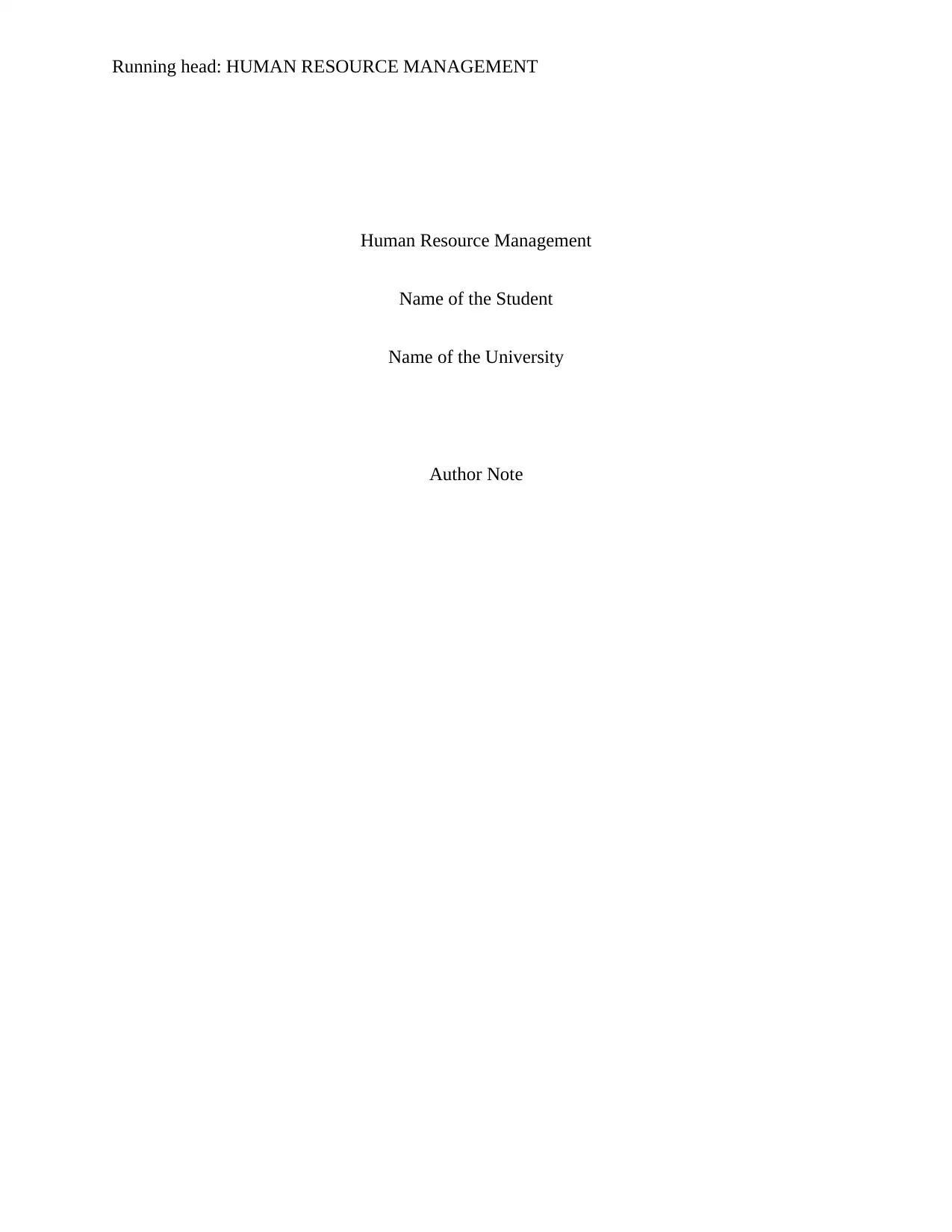
Running head: HUMAN RESOURCE MANAGEMENT
Human Resource Management
Name of the Student
Name of the University
Author Note
Human Resource Management
Name of the Student
Name of the University
Author Note
Paraphrase This Document
Need a fresh take? Get an instant paraphrase of this document with our AI Paraphraser
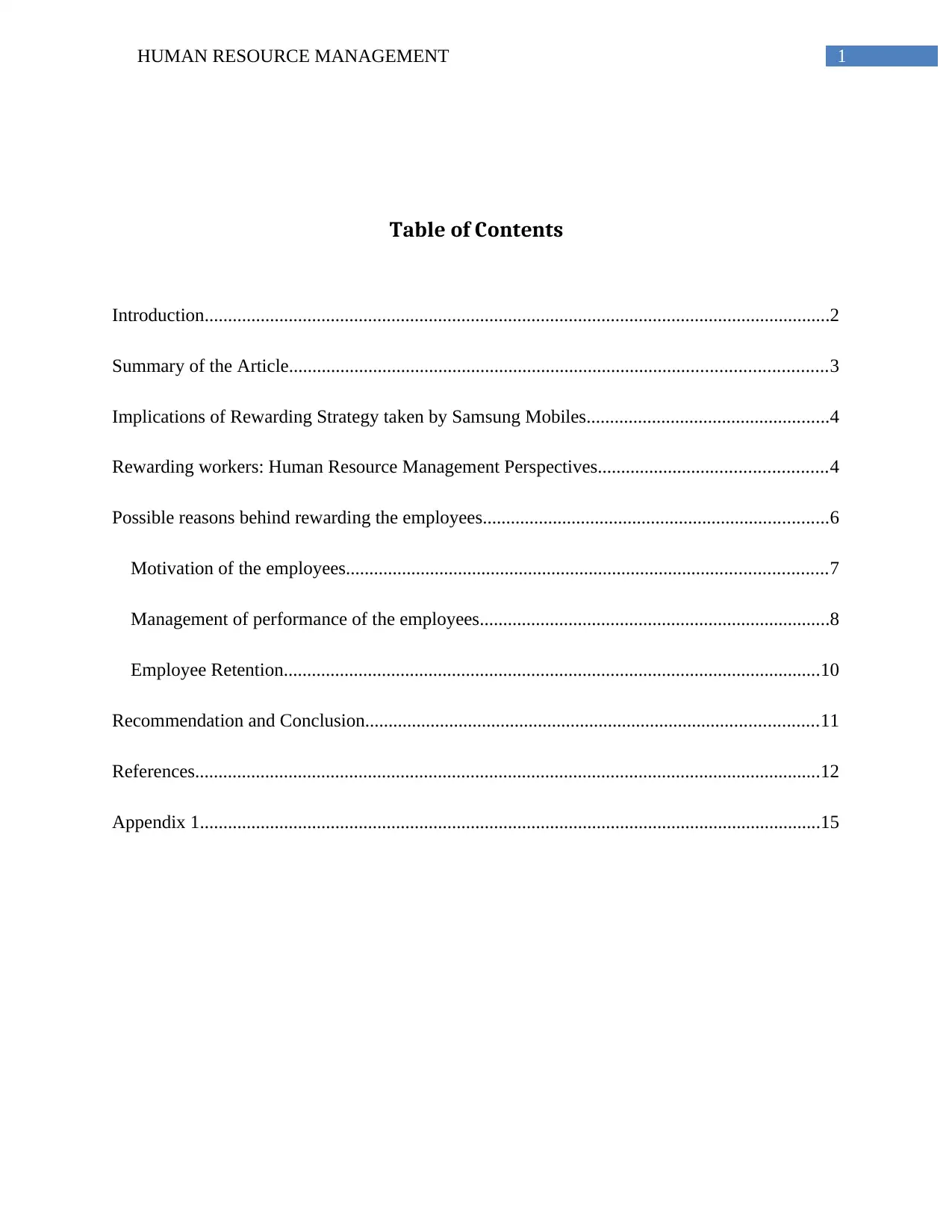
1HUMAN RESOURCE MANAGEMENT
Table of Contents
Introduction......................................................................................................................................2
Summary of the Article...................................................................................................................3
Implications of Rewarding Strategy taken by Samsung Mobiles....................................................4
Rewarding workers: Human Resource Management Perspectives.................................................4
Possible reasons behind rewarding the employees..........................................................................6
Motivation of the employees.......................................................................................................7
Management of performance of the employees...........................................................................8
Employee Retention...................................................................................................................10
Recommendation and Conclusion.................................................................................................11
References......................................................................................................................................12
Appendix 1.....................................................................................................................................15
Table of Contents
Introduction......................................................................................................................................2
Summary of the Article...................................................................................................................3
Implications of Rewarding Strategy taken by Samsung Mobiles....................................................4
Rewarding workers: Human Resource Management Perspectives.................................................4
Possible reasons behind rewarding the employees..........................................................................6
Motivation of the employees.......................................................................................................7
Management of performance of the employees...........................................................................8
Employee Retention...................................................................................................................10
Recommendation and Conclusion.................................................................................................11
References......................................................................................................................................12
Appendix 1.....................................................................................................................................15
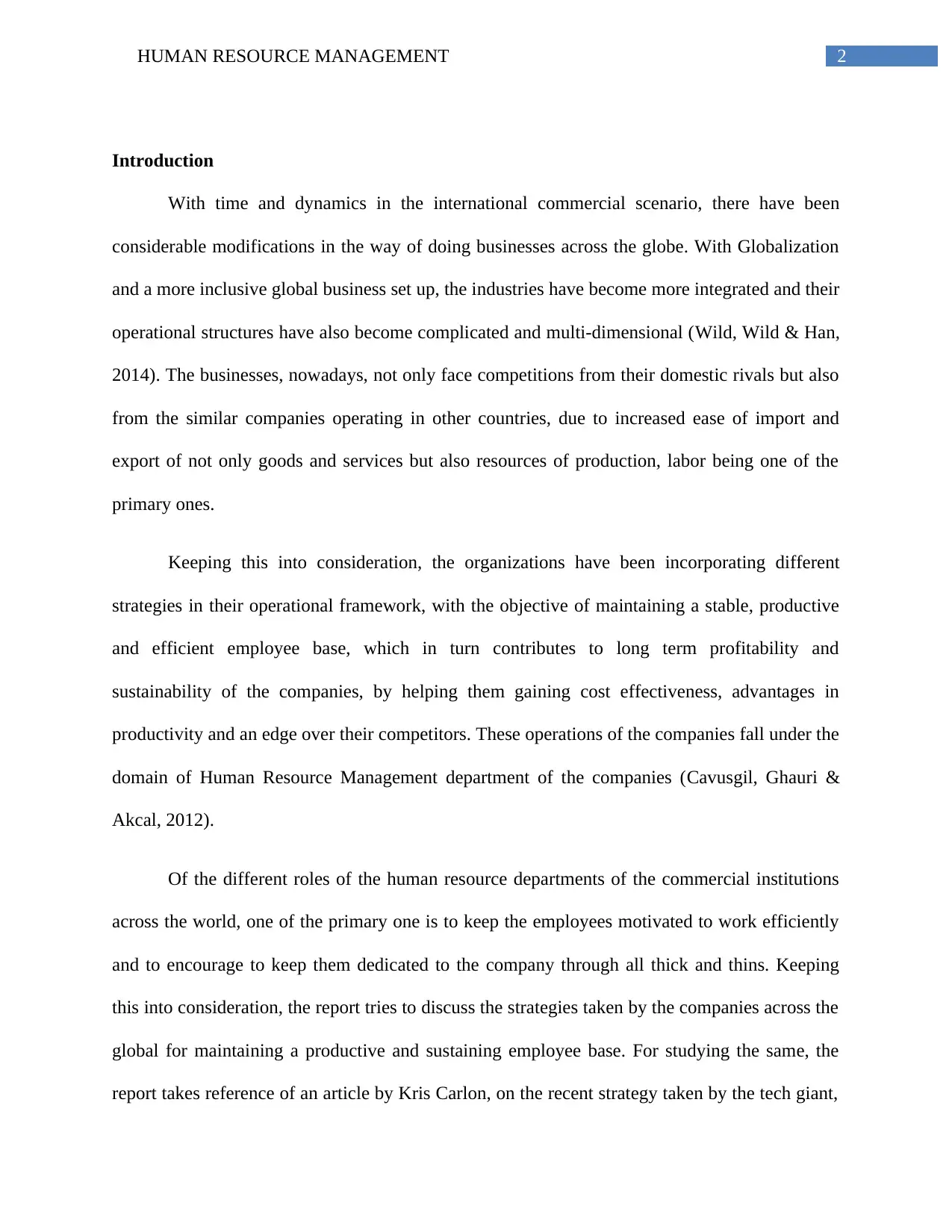
2HUMAN RESOURCE MANAGEMENT
Introduction
With time and dynamics in the international commercial scenario, there have been
considerable modifications in the way of doing businesses across the globe. With Globalization
and a more inclusive global business set up, the industries have become more integrated and their
operational structures have also become complicated and multi-dimensional (Wild, Wild & Han,
2014). The businesses, nowadays, not only face competitions from their domestic rivals but also
from the similar companies operating in other countries, due to increased ease of import and
export of not only goods and services but also resources of production, labor being one of the
primary ones.
Keeping this into consideration, the organizations have been incorporating different
strategies in their operational framework, with the objective of maintaining a stable, productive
and efficient employee base, which in turn contributes to long term profitability and
sustainability of the companies, by helping them gaining cost effectiveness, advantages in
productivity and an edge over their competitors. These operations of the companies fall under the
domain of Human Resource Management department of the companies (Cavusgil, Ghauri &
Akcal, 2012).
Of the different roles of the human resource departments of the commercial institutions
across the world, one of the primary one is to keep the employees motivated to work efficiently
and to encourage to keep them dedicated to the company through all thick and thins. Keeping
this into consideration, the report tries to discuss the strategies taken by the companies across the
global for maintaining a productive and sustaining employee base. For studying the same, the
report takes reference of an article by Kris Carlon, on the recent strategy taken by the tech giant,
Introduction
With time and dynamics in the international commercial scenario, there have been
considerable modifications in the way of doing businesses across the globe. With Globalization
and a more inclusive global business set up, the industries have become more integrated and their
operational structures have also become complicated and multi-dimensional (Wild, Wild & Han,
2014). The businesses, nowadays, not only face competitions from their domestic rivals but also
from the similar companies operating in other countries, due to increased ease of import and
export of not only goods and services but also resources of production, labor being one of the
primary ones.
Keeping this into consideration, the organizations have been incorporating different
strategies in their operational framework, with the objective of maintaining a stable, productive
and efficient employee base, which in turn contributes to long term profitability and
sustainability of the companies, by helping them gaining cost effectiveness, advantages in
productivity and an edge over their competitors. These operations of the companies fall under the
domain of Human Resource Management department of the companies (Cavusgil, Ghauri &
Akcal, 2012).
Of the different roles of the human resource departments of the commercial institutions
across the world, one of the primary one is to keep the employees motivated to work efficiently
and to encourage to keep them dedicated to the company through all thick and thins. Keeping
this into consideration, the report tries to discuss the strategies taken by the companies across the
global for maintaining a productive and sustaining employee base. For studying the same, the
report takes reference of an article by Kris Carlon, on the recent strategy taken by the tech giant,
⊘ This is a preview!⊘
Do you want full access?
Subscribe today to unlock all pages.

Trusted by 1+ million students worldwide
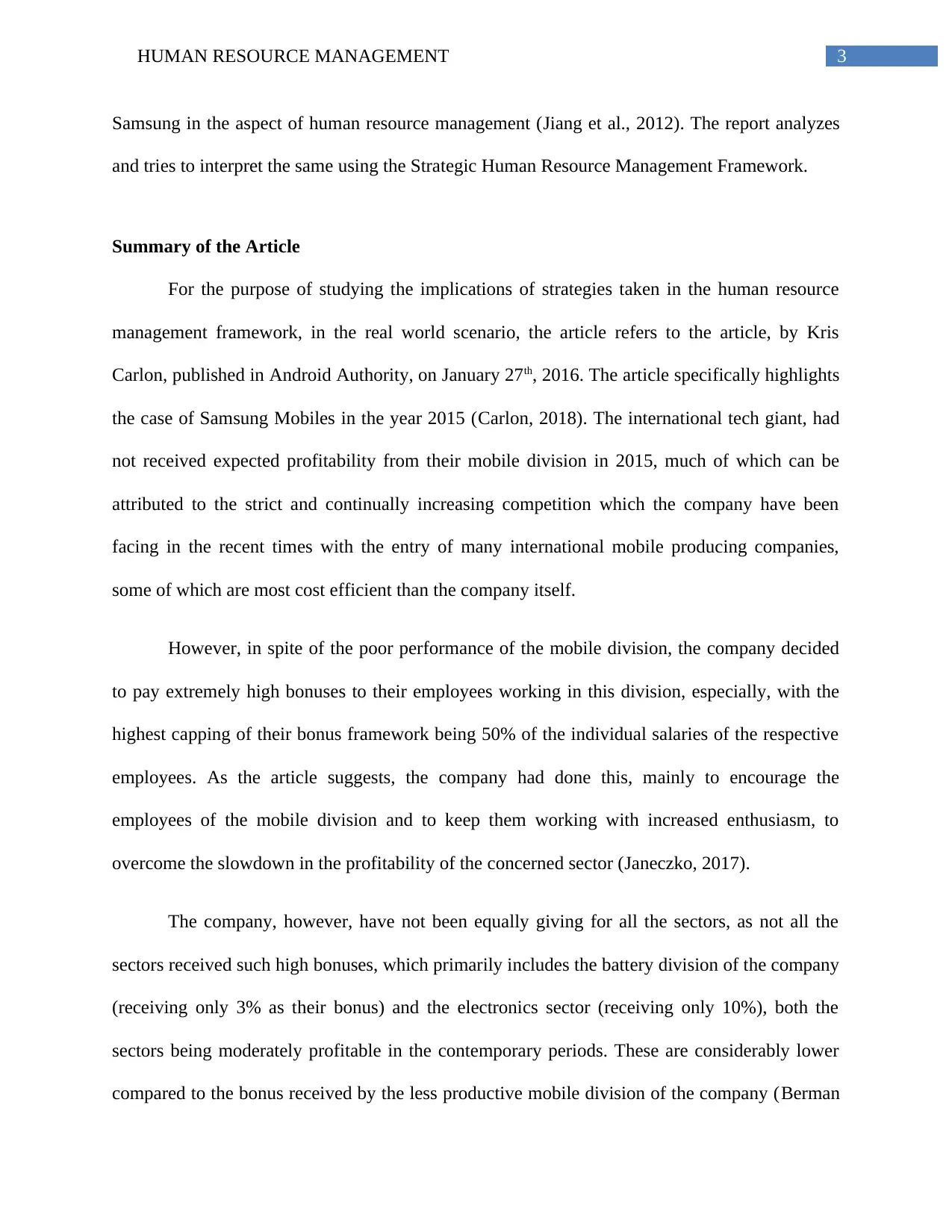
3HUMAN RESOURCE MANAGEMENT
Samsung in the aspect of human resource management (Jiang et al., 2012). The report analyzes
and tries to interpret the same using the Strategic Human Resource Management Framework.
Summary of the Article
For the purpose of studying the implications of strategies taken in the human resource
management framework, in the real world scenario, the article refers to the article, by Kris
Carlon, published in Android Authority, on January 27th, 2016. The article specifically highlights
the case of Samsung Mobiles in the year 2015 (Carlon, 2018). The international tech giant, had
not received expected profitability from their mobile division in 2015, much of which can be
attributed to the strict and continually increasing competition which the company have been
facing in the recent times with the entry of many international mobile producing companies,
some of which are most cost efficient than the company itself.
However, in spite of the poor performance of the mobile division, the company decided
to pay extremely high bonuses to their employees working in this division, especially, with the
highest capping of their bonus framework being 50% of the individual salaries of the respective
employees. As the article suggests, the company had done this, mainly to encourage the
employees of the mobile division and to keep them working with increased enthusiasm, to
overcome the slowdown in the profitability of the concerned sector (Janeczko, 2017).
The company, however, have not been equally giving for all the sectors, as not all the
sectors received such high bonuses, which primarily includes the battery division of the company
(receiving only 3% as their bonus) and the electronics sector (receiving only 10%), both the
sectors being moderately profitable in the contemporary periods. These are considerably lower
compared to the bonus received by the less productive mobile division of the company (Berman
Samsung in the aspect of human resource management (Jiang et al., 2012). The report analyzes
and tries to interpret the same using the Strategic Human Resource Management Framework.
Summary of the Article
For the purpose of studying the implications of strategies taken in the human resource
management framework, in the real world scenario, the article refers to the article, by Kris
Carlon, published in Android Authority, on January 27th, 2016. The article specifically highlights
the case of Samsung Mobiles in the year 2015 (Carlon, 2018). The international tech giant, had
not received expected profitability from their mobile division in 2015, much of which can be
attributed to the strict and continually increasing competition which the company have been
facing in the recent times with the entry of many international mobile producing companies,
some of which are most cost efficient than the company itself.
However, in spite of the poor performance of the mobile division, the company decided
to pay extremely high bonuses to their employees working in this division, especially, with the
highest capping of their bonus framework being 50% of the individual salaries of the respective
employees. As the article suggests, the company had done this, mainly to encourage the
employees of the mobile division and to keep them working with increased enthusiasm, to
overcome the slowdown in the profitability of the concerned sector (Janeczko, 2017).
The company, however, have not been equally giving for all the sectors, as not all the
sectors received such high bonuses, which primarily includes the battery division of the company
(receiving only 3% as their bonus) and the electronics sector (receiving only 10%), both the
sectors being moderately profitable in the contemporary periods. These are considerably lower
compared to the bonus received by the less productive mobile division of the company (Berman
Paraphrase This Document
Need a fresh take? Get an instant paraphrase of this document with our AI Paraphraser
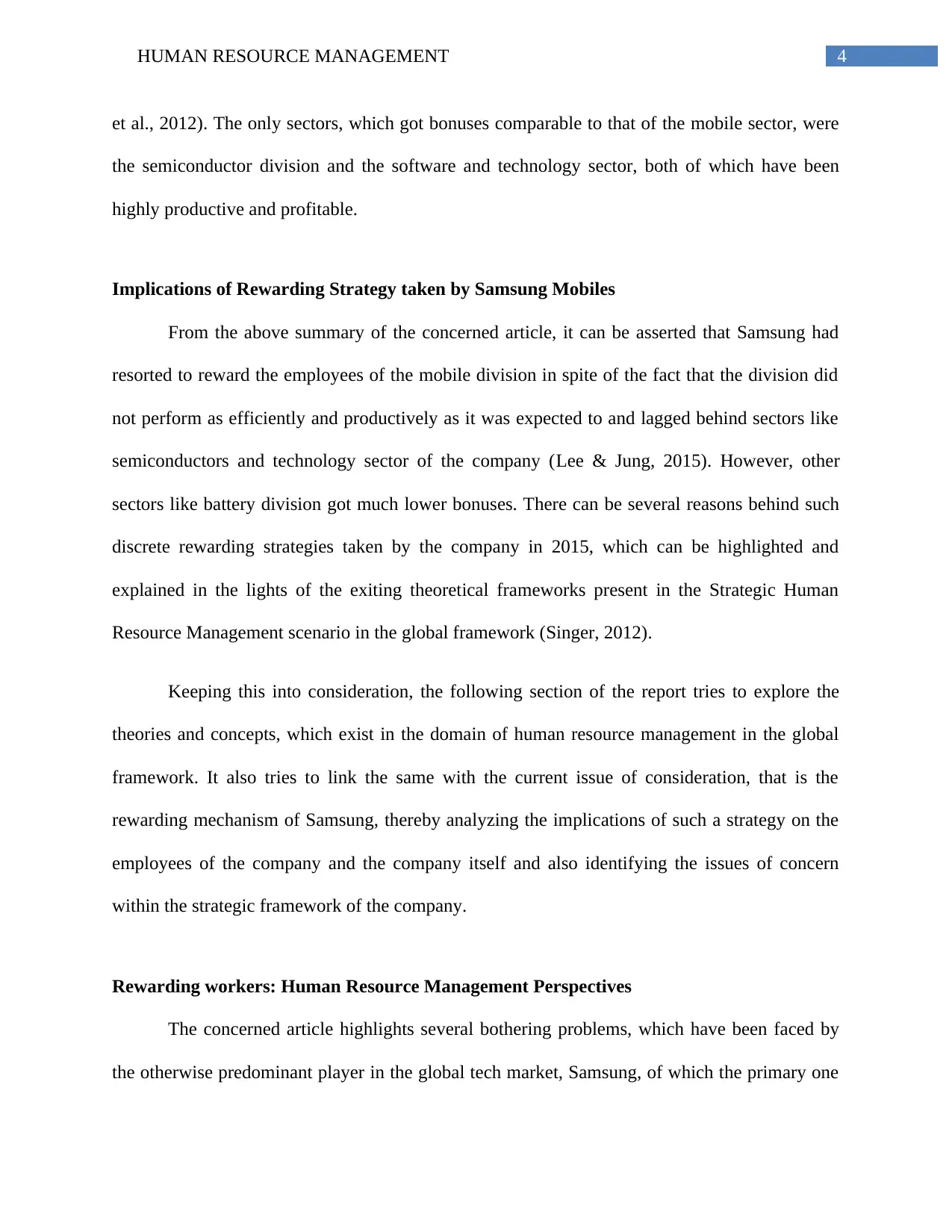
4HUMAN RESOURCE MANAGEMENT
et al., 2012). The only sectors, which got bonuses comparable to that of the mobile sector, were
the semiconductor division and the software and technology sector, both of which have been
highly productive and profitable.
Implications of Rewarding Strategy taken by Samsung Mobiles
From the above summary of the concerned article, it can be asserted that Samsung had
resorted to reward the employees of the mobile division in spite of the fact that the division did
not perform as efficiently and productively as it was expected to and lagged behind sectors like
semiconductors and technology sector of the company (Lee & Jung, 2015). However, other
sectors like battery division got much lower bonuses. There can be several reasons behind such
discrete rewarding strategies taken by the company in 2015, which can be highlighted and
explained in the lights of the exiting theoretical frameworks present in the Strategic Human
Resource Management scenario in the global framework (Singer, 2012).
Keeping this into consideration, the following section of the report tries to explore the
theories and concepts, which exist in the domain of human resource management in the global
framework. It also tries to link the same with the current issue of consideration, that is the
rewarding mechanism of Samsung, thereby analyzing the implications of such a strategy on the
employees of the company and the company itself and also identifying the issues of concern
within the strategic framework of the company.
Rewarding workers: Human Resource Management Perspectives
The concerned article highlights several bothering problems, which have been faced by
the otherwise predominant player in the global tech market, Samsung, of which the primary one
et al., 2012). The only sectors, which got bonuses comparable to that of the mobile sector, were
the semiconductor division and the software and technology sector, both of which have been
highly productive and profitable.
Implications of Rewarding Strategy taken by Samsung Mobiles
From the above summary of the concerned article, it can be asserted that Samsung had
resorted to reward the employees of the mobile division in spite of the fact that the division did
not perform as efficiently and productively as it was expected to and lagged behind sectors like
semiconductors and technology sector of the company (Lee & Jung, 2015). However, other
sectors like battery division got much lower bonuses. There can be several reasons behind such
discrete rewarding strategies taken by the company in 2015, which can be highlighted and
explained in the lights of the exiting theoretical frameworks present in the Strategic Human
Resource Management scenario in the global framework (Singer, 2012).
Keeping this into consideration, the following section of the report tries to explore the
theories and concepts, which exist in the domain of human resource management in the global
framework. It also tries to link the same with the current issue of consideration, that is the
rewarding mechanism of Samsung, thereby analyzing the implications of such a strategy on the
employees of the company and the company itself and also identifying the issues of concern
within the strategic framework of the company.
Rewarding workers: Human Resource Management Perspectives
The concerned article highlights several bothering problems, which have been faced by
the otherwise predominant player in the global tech market, Samsung, of which the primary one
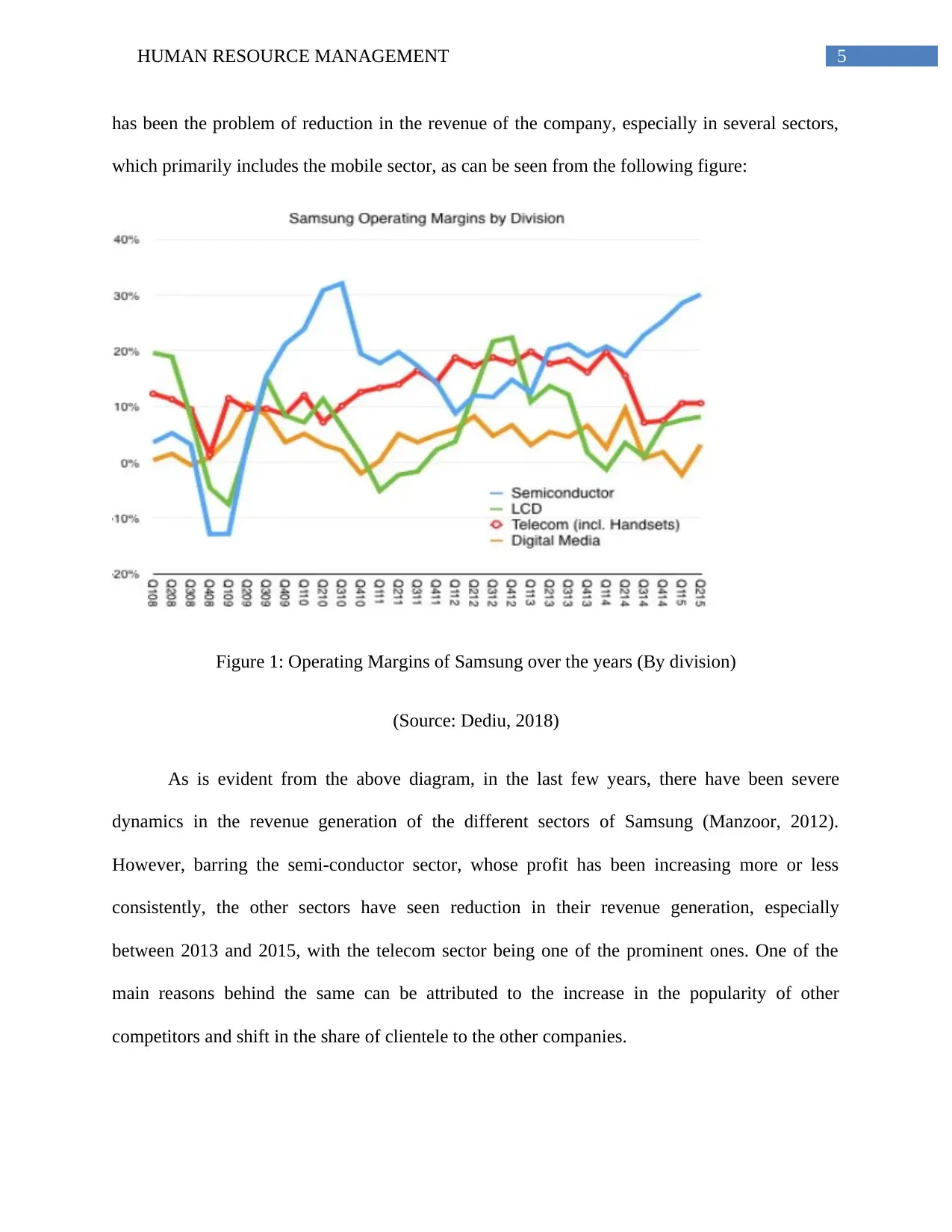
5HUMAN RESOURCE MANAGEMENT
has been the problem of reduction in the revenue of the company, especially in several sectors,
which primarily includes the mobile sector, as can be seen from the following figure:
Figure 1: Operating Margins of Samsung over the years (By division)
(Source: Dediu, 2018)
As is evident from the above diagram, in the last few years, there have been severe
dynamics in the revenue generation of the different sectors of Samsung (Manzoor, 2012).
However, barring the semi-conductor sector, whose profit has been increasing more or less
consistently, the other sectors have seen reduction in their revenue generation, especially
between 2013 and 2015, with the telecom sector being one of the prominent ones. One of the
main reasons behind the same can be attributed to the increase in the popularity of other
competitors and shift in the share of clientele to the other companies.
has been the problem of reduction in the revenue of the company, especially in several sectors,
which primarily includes the mobile sector, as can be seen from the following figure:
Figure 1: Operating Margins of Samsung over the years (By division)
(Source: Dediu, 2018)
As is evident from the above diagram, in the last few years, there have been severe
dynamics in the revenue generation of the different sectors of Samsung (Manzoor, 2012).
However, barring the semi-conductor sector, whose profit has been increasing more or less
consistently, the other sectors have seen reduction in their revenue generation, especially
between 2013 and 2015, with the telecom sector being one of the prominent ones. One of the
main reasons behind the same can be attributed to the increase in the popularity of other
competitors and shift in the share of clientele to the other companies.
⊘ This is a preview!⊘
Do you want full access?
Subscribe today to unlock all pages.

Trusted by 1+ million students worldwide
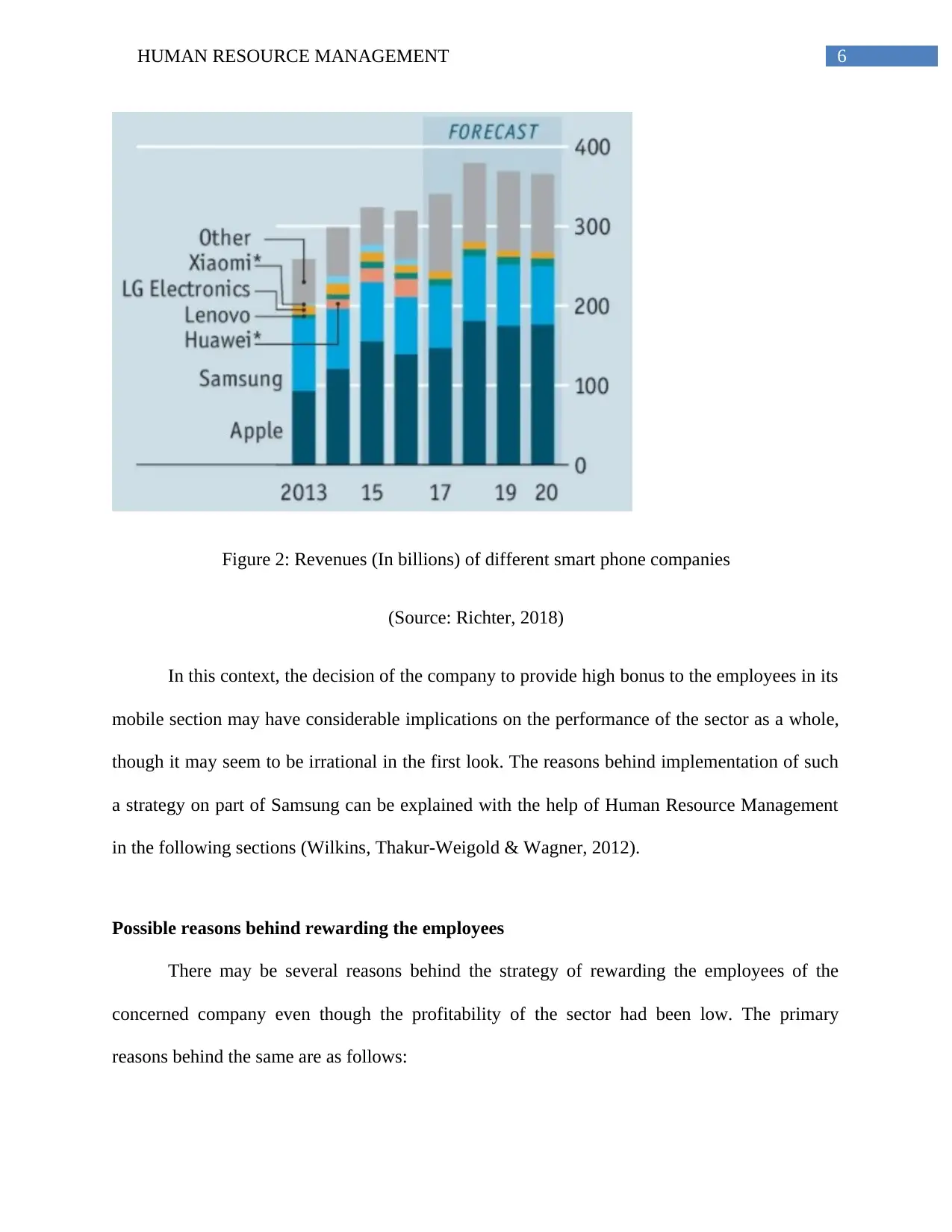
6HUMAN RESOURCE MANAGEMENT
Figure 2: Revenues (In billions) of different smart phone companies
(Source: Richter, 2018)
In this context, the decision of the company to provide high bonus to the employees in its
mobile section may have considerable implications on the performance of the sector as a whole,
though it may seem to be irrational in the first look. The reasons behind implementation of such
a strategy on part of Samsung can be explained with the help of Human Resource Management
in the following sections (Wilkins, Thakur-Weigold & Wagner, 2012).
Possible reasons behind rewarding the employees
There may be several reasons behind the strategy of rewarding the employees of the
concerned company even though the profitability of the sector had been low. The primary
reasons behind the same are as follows:
Figure 2: Revenues (In billions) of different smart phone companies
(Source: Richter, 2018)
In this context, the decision of the company to provide high bonus to the employees in its
mobile section may have considerable implications on the performance of the sector as a whole,
though it may seem to be irrational in the first look. The reasons behind implementation of such
a strategy on part of Samsung can be explained with the help of Human Resource Management
in the following sections (Wilkins, Thakur-Weigold & Wagner, 2012).
Possible reasons behind rewarding the employees
There may be several reasons behind the strategy of rewarding the employees of the
concerned company even though the profitability of the sector had been low. The primary
reasons behind the same are as follows:
Paraphrase This Document
Need a fresh take? Get an instant paraphrase of this document with our AI Paraphraser
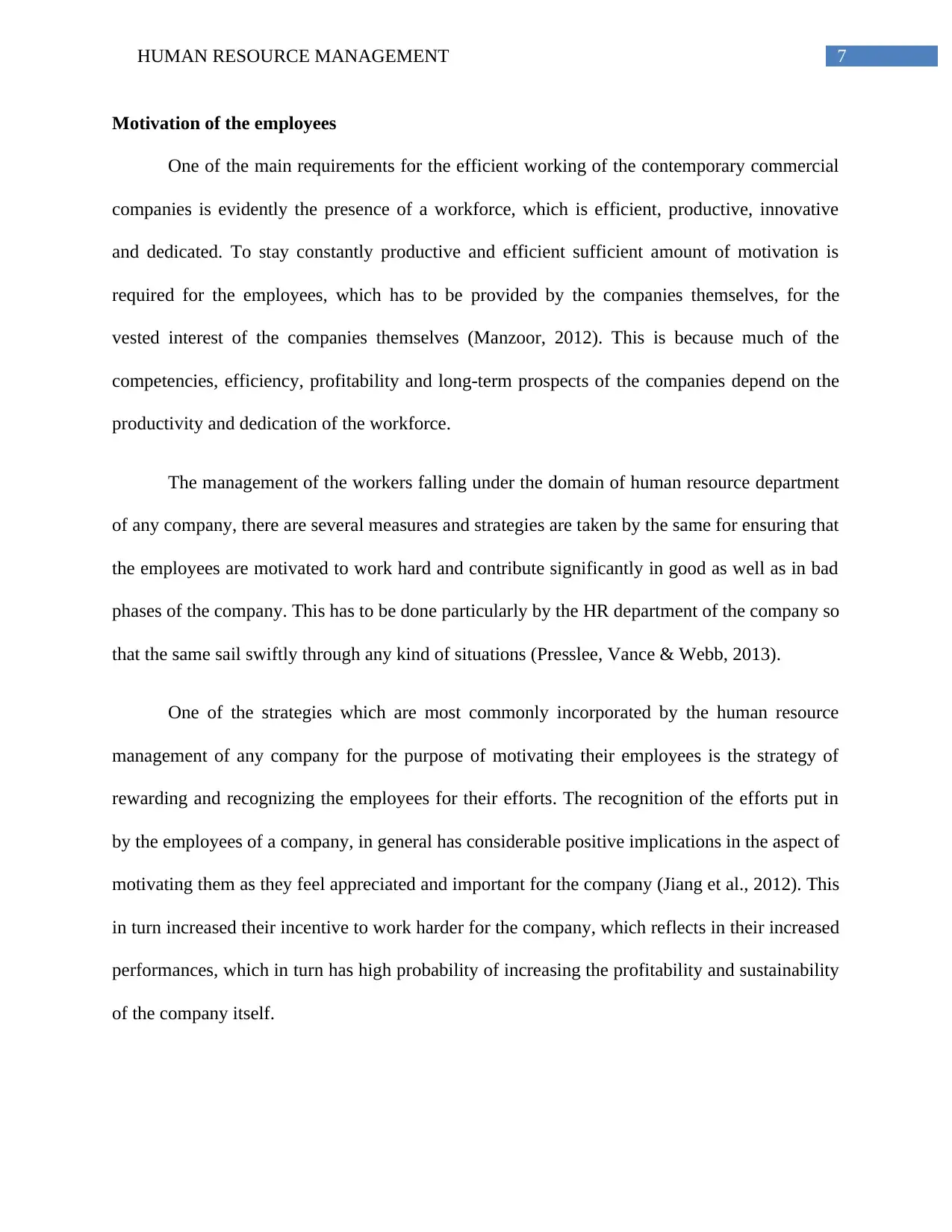
7HUMAN RESOURCE MANAGEMENT
Motivation of the employees
One of the main requirements for the efficient working of the contemporary commercial
companies is evidently the presence of a workforce, which is efficient, productive, innovative
and dedicated. To stay constantly productive and efficient sufficient amount of motivation is
required for the employees, which has to be provided by the companies themselves, for the
vested interest of the companies themselves (Manzoor, 2012). This is because much of the
competencies, efficiency, profitability and long-term prospects of the companies depend on the
productivity and dedication of the workforce.
The management of the workers falling under the domain of human resource department
of any company, there are several measures and strategies are taken by the same for ensuring that
the employees are motivated to work hard and contribute significantly in good as well as in bad
phases of the company. This has to be done particularly by the HR department of the company so
that the same sail swiftly through any kind of situations (Presslee, Vance & Webb, 2013).
One of the strategies which are most commonly incorporated by the human resource
management of any company for the purpose of motivating their employees is the strategy of
rewarding and recognizing the employees for their efforts. The recognition of the efforts put in
by the employees of a company, in general has considerable positive implications in the aspect of
motivating them as they feel appreciated and important for the company (Jiang et al., 2012). This
in turn increased their incentive to work harder for the company, which reflects in their increased
performances, which in turn has high probability of increasing the profitability and sustainability
of the company itself.
Motivation of the employees
One of the main requirements for the efficient working of the contemporary commercial
companies is evidently the presence of a workforce, which is efficient, productive, innovative
and dedicated. To stay constantly productive and efficient sufficient amount of motivation is
required for the employees, which has to be provided by the companies themselves, for the
vested interest of the companies themselves (Manzoor, 2012). This is because much of the
competencies, efficiency, profitability and long-term prospects of the companies depend on the
productivity and dedication of the workforce.
The management of the workers falling under the domain of human resource department
of any company, there are several measures and strategies are taken by the same for ensuring that
the employees are motivated to work hard and contribute significantly in good as well as in bad
phases of the company. This has to be done particularly by the HR department of the company so
that the same sail swiftly through any kind of situations (Presslee, Vance & Webb, 2013).
One of the strategies which are most commonly incorporated by the human resource
management of any company for the purpose of motivating their employees is the strategy of
rewarding and recognizing the employees for their efforts. The recognition of the efforts put in
by the employees of a company, in general has considerable positive implications in the aspect of
motivating them as they feel appreciated and important for the company (Jiang et al., 2012). This
in turn increased their incentive to work harder for the company, which reflects in their increased
performances, which in turn has high probability of increasing the profitability and sustainability
of the company itself.
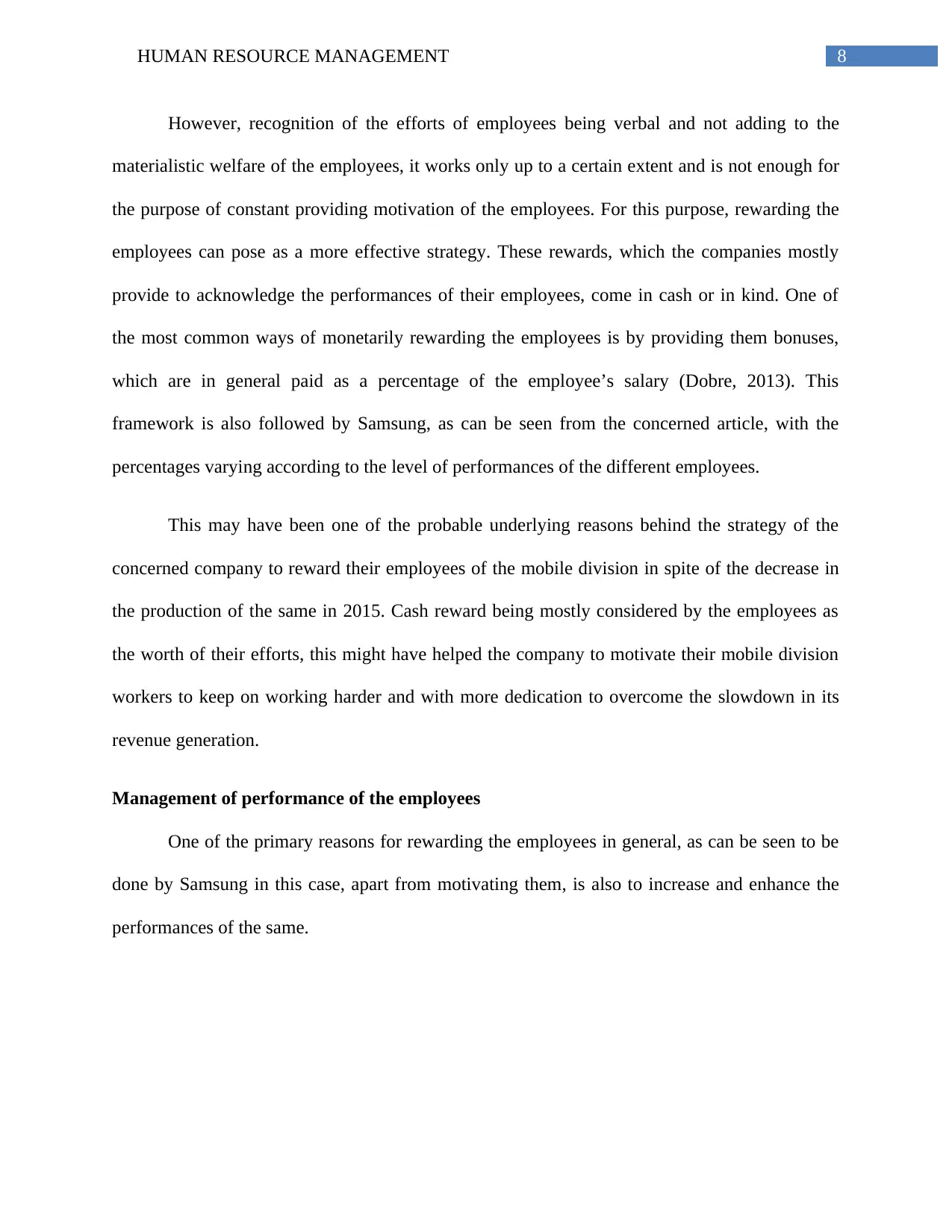
8HUMAN RESOURCE MANAGEMENT
However, recognition of the efforts of employees being verbal and not adding to the
materialistic welfare of the employees, it works only up to a certain extent and is not enough for
the purpose of constant providing motivation of the employees. For this purpose, rewarding the
employees can pose as a more effective strategy. These rewards, which the companies mostly
provide to acknowledge the performances of their employees, come in cash or in kind. One of
the most common ways of monetarily rewarding the employees is by providing them bonuses,
which are in general paid as a percentage of the employee’s salary (Dobre, 2013). This
framework is also followed by Samsung, as can be seen from the concerned article, with the
percentages varying according to the level of performances of the different employees.
This may have been one of the probable underlying reasons behind the strategy of the
concerned company to reward their employees of the mobile division in spite of the decrease in
the production of the same in 2015. Cash reward being mostly considered by the employees as
the worth of their efforts, this might have helped the company to motivate their mobile division
workers to keep on working harder and with more dedication to overcome the slowdown in its
revenue generation.
Management of performance of the employees
One of the primary reasons for rewarding the employees in general, as can be seen to be
done by Samsung in this case, apart from motivating them, is also to increase and enhance the
performances of the same.
However, recognition of the efforts of employees being verbal and not adding to the
materialistic welfare of the employees, it works only up to a certain extent and is not enough for
the purpose of constant providing motivation of the employees. For this purpose, rewarding the
employees can pose as a more effective strategy. These rewards, which the companies mostly
provide to acknowledge the performances of their employees, come in cash or in kind. One of
the most common ways of monetarily rewarding the employees is by providing them bonuses,
which are in general paid as a percentage of the employee’s salary (Dobre, 2013). This
framework is also followed by Samsung, as can be seen from the concerned article, with the
percentages varying according to the level of performances of the different employees.
This may have been one of the probable underlying reasons behind the strategy of the
concerned company to reward their employees of the mobile division in spite of the decrease in
the production of the same in 2015. Cash reward being mostly considered by the employees as
the worth of their efforts, this might have helped the company to motivate their mobile division
workers to keep on working harder and with more dedication to overcome the slowdown in its
revenue generation.
Management of performance of the employees
One of the primary reasons for rewarding the employees in general, as can be seen to be
done by Samsung in this case, apart from motivating them, is also to increase and enhance the
performances of the same.
⊘ This is a preview!⊘
Do you want full access?
Subscribe today to unlock all pages.

Trusted by 1+ million students worldwide
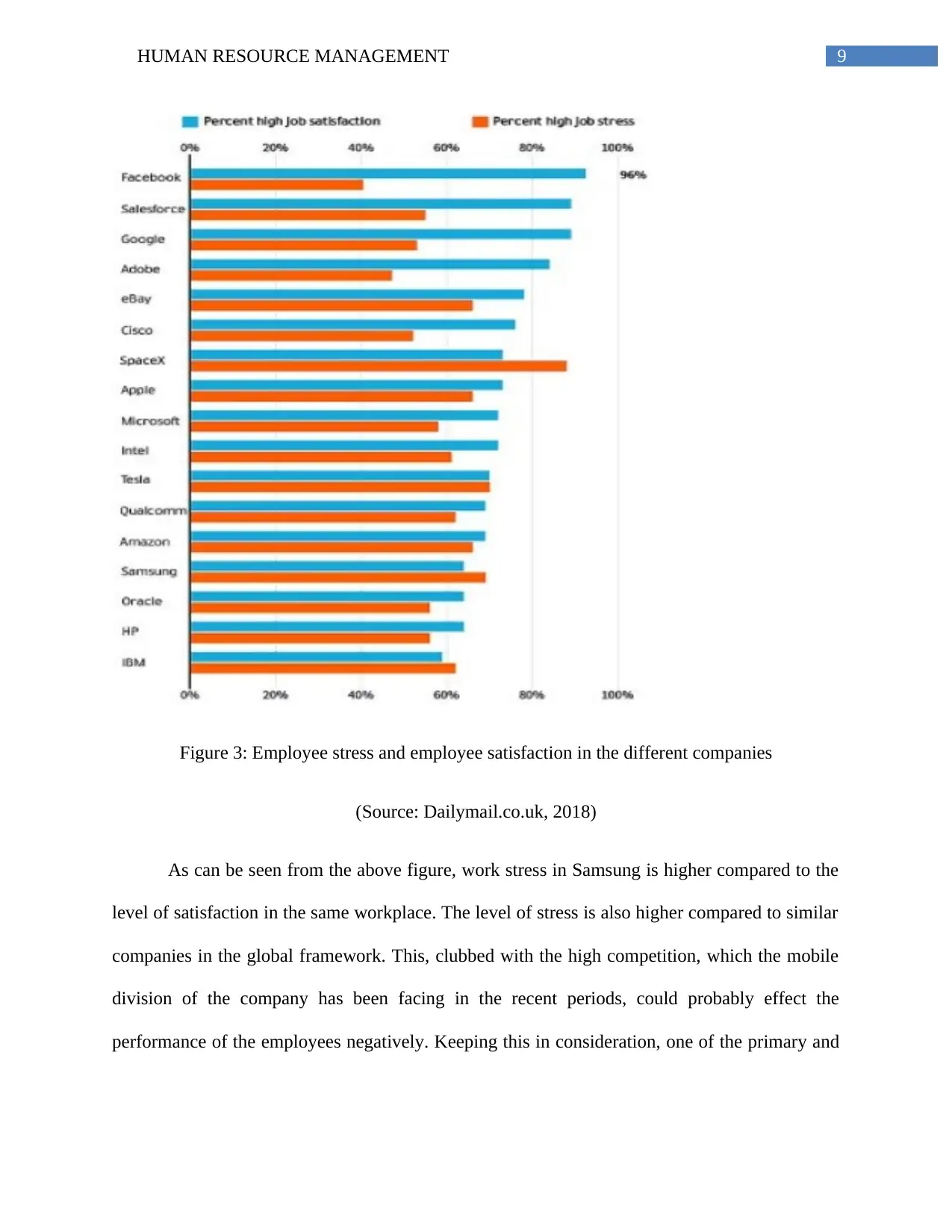
9HUMAN RESOURCE MANAGEMENT
Figure 3: Employee stress and employee satisfaction in the different companies
(Source: Dailymail.co.uk, 2018)
As can be seen from the above figure, work stress in Samsung is higher compared to the
level of satisfaction in the same workplace. The level of stress is also higher compared to similar
companies in the global framework. This, clubbed with the high competition, which the mobile
division of the company has been facing in the recent periods, could probably effect the
performance of the employees negatively. Keeping this in consideration, one of the primary and
Figure 3: Employee stress and employee satisfaction in the different companies
(Source: Dailymail.co.uk, 2018)
As can be seen from the above figure, work stress in Samsung is higher compared to the
level of satisfaction in the same workplace. The level of stress is also higher compared to similar
companies in the global framework. This, clubbed with the high competition, which the mobile
division of the company has been facing in the recent periods, could probably effect the
performance of the employees negatively. Keeping this in consideration, one of the primary and
Paraphrase This Document
Need a fresh take? Get an instant paraphrase of this document with our AI Paraphraser
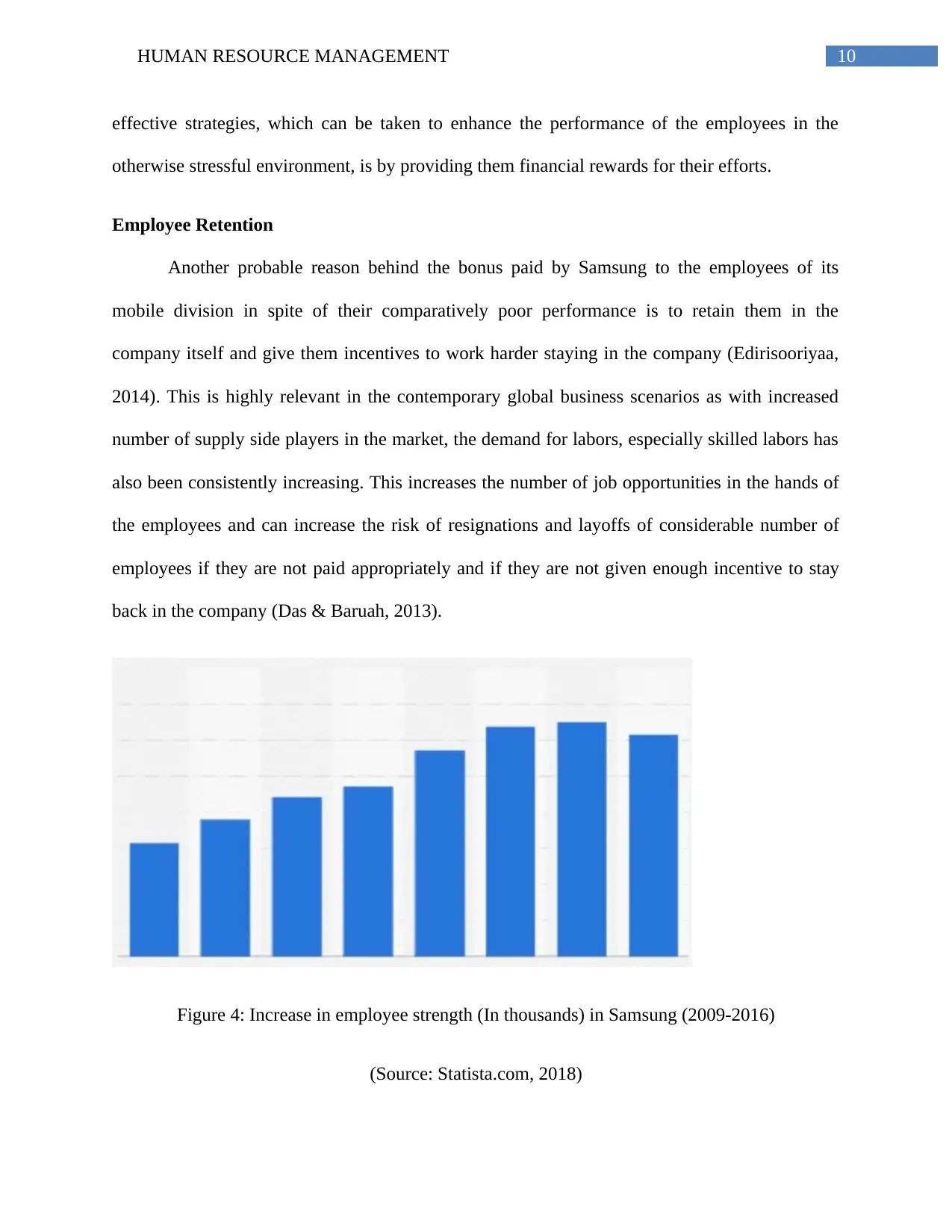
10HUMAN RESOURCE MANAGEMENT
effective strategies, which can be taken to enhance the performance of the employees in the
otherwise stressful environment, is by providing them financial rewards for their efforts.
Employee Retention
Another probable reason behind the bonus paid by Samsung to the employees of its
mobile division in spite of their comparatively poor performance is to retain them in the
company itself and give them incentives to work harder staying in the company (Edirisooriyaa,
2014). This is highly relevant in the contemporary global business scenarios as with increased
number of supply side players in the market, the demand for labors, especially skilled labors has
also been consistently increasing. This increases the number of job opportunities in the hands of
the employees and can increase the risk of resignations and layoffs of considerable number of
employees if they are not paid appropriately and if they are not given enough incentive to stay
back in the company (Das & Baruah, 2013).
Figure 4: Increase in employee strength (In thousands) in Samsung (2009-2016)
(Source: Statista.com, 2018)
effective strategies, which can be taken to enhance the performance of the employees in the
otherwise stressful environment, is by providing them financial rewards for their efforts.
Employee Retention
Another probable reason behind the bonus paid by Samsung to the employees of its
mobile division in spite of their comparatively poor performance is to retain them in the
company itself and give them incentives to work harder staying in the company (Edirisooriyaa,
2014). This is highly relevant in the contemporary global business scenarios as with increased
number of supply side players in the market, the demand for labors, especially skilled labors has
also been consistently increasing. This increases the number of job opportunities in the hands of
the employees and can increase the risk of resignations and layoffs of considerable number of
employees if they are not paid appropriately and if they are not given enough incentive to stay
back in the company (Das & Baruah, 2013).
Figure 4: Increase in employee strength (In thousands) in Samsung (2009-2016)
(Source: Statista.com, 2018)
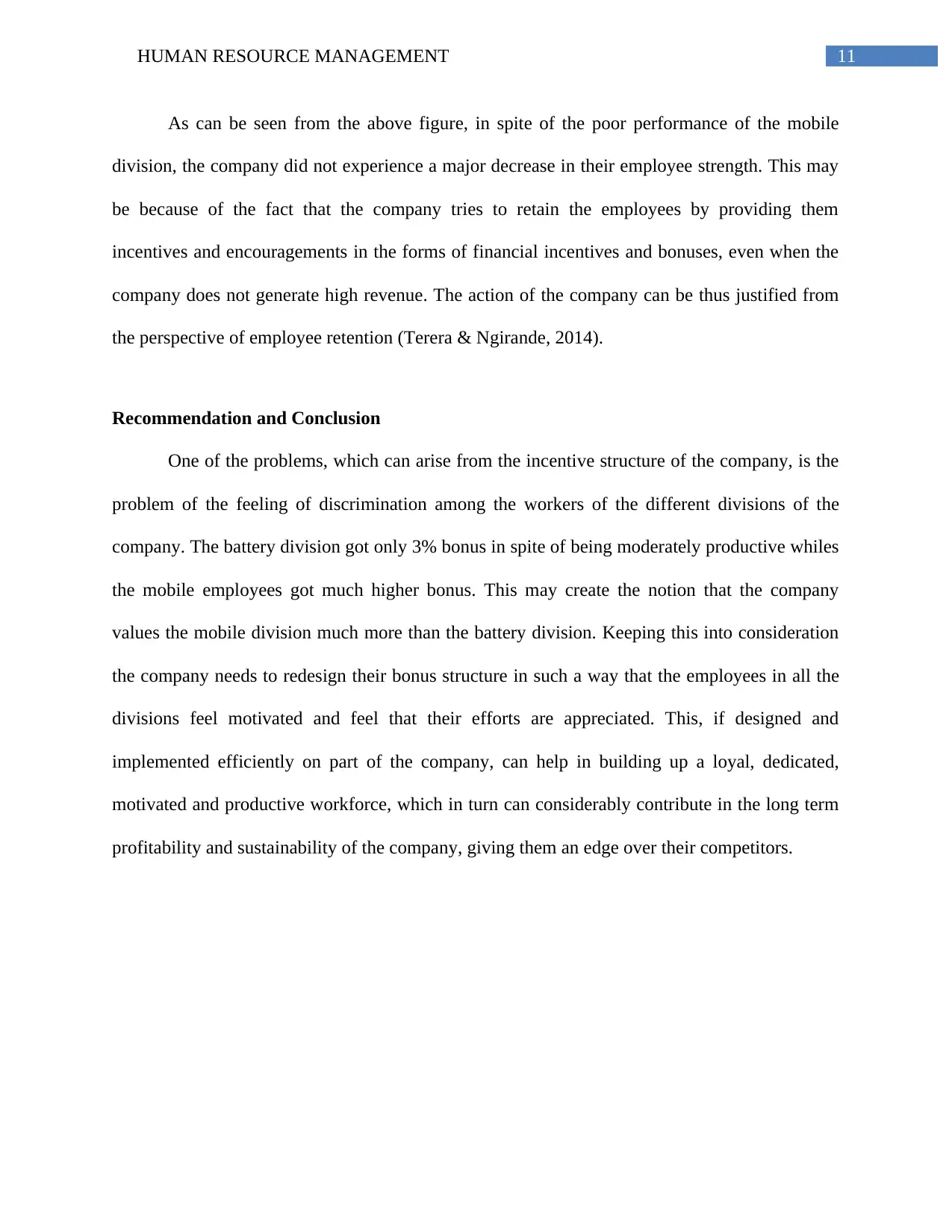
11HUMAN RESOURCE MANAGEMENT
As can be seen from the above figure, in spite of the poor performance of the mobile
division, the company did not experience a major decrease in their employee strength. This may
be because of the fact that the company tries to retain the employees by providing them
incentives and encouragements in the forms of financial incentives and bonuses, even when the
company does not generate high revenue. The action of the company can be thus justified from
the perspective of employee retention (Terera & Ngirande, 2014).
Recommendation and Conclusion
One of the problems, which can arise from the incentive structure of the company, is the
problem of the feeling of discrimination among the workers of the different divisions of the
company. The battery division got only 3% bonus in spite of being moderately productive whiles
the mobile employees got much higher bonus. This may create the notion that the company
values the mobile division much more than the battery division. Keeping this into consideration
the company needs to redesign their bonus structure in such a way that the employees in all the
divisions feel motivated and feel that their efforts are appreciated. This, if designed and
implemented efficiently on part of the company, can help in building up a loyal, dedicated,
motivated and productive workforce, which in turn can considerably contribute in the long term
profitability and sustainability of the company, giving them an edge over their competitors.
As can be seen from the above figure, in spite of the poor performance of the mobile
division, the company did not experience a major decrease in their employee strength. This may
be because of the fact that the company tries to retain the employees by providing them
incentives and encouragements in the forms of financial incentives and bonuses, even when the
company does not generate high revenue. The action of the company can be thus justified from
the perspective of employee retention (Terera & Ngirande, 2014).
Recommendation and Conclusion
One of the problems, which can arise from the incentive structure of the company, is the
problem of the feeling of discrimination among the workers of the different divisions of the
company. The battery division got only 3% bonus in spite of being moderately productive whiles
the mobile employees got much higher bonus. This may create the notion that the company
values the mobile division much more than the battery division. Keeping this into consideration
the company needs to redesign their bonus structure in such a way that the employees in all the
divisions feel motivated and feel that their efforts are appreciated. This, if designed and
implemented efficiently on part of the company, can help in building up a loyal, dedicated,
motivated and productive workforce, which in turn can considerably contribute in the long term
profitability and sustainability of the company, giving them an edge over their competitors.
⊘ This is a preview!⊘
Do you want full access?
Subscribe today to unlock all pages.

Trusted by 1+ million students worldwide
1 out of 17
Related Documents
Your All-in-One AI-Powered Toolkit for Academic Success.
+13062052269
info@desklib.com
Available 24*7 on WhatsApp / Email
![[object Object]](/_next/static/media/star-bottom.7253800d.svg)
Unlock your academic potential
Copyright © 2020–2025 A2Z Services. All Rights Reserved. Developed and managed by ZUCOL.





